Evaluating Health and Safety Risks for Workers in Confined Spaces
VerifiedAdded on 2023/06/07
|31
|8540
|367
Report
AI Summary
This report explores the occupational health and safety risks affecting workers in confined spaces, particularly manholes. It highlights factors contributing to injuries, such as reliance on temporary workers, lack of training, and inadequate hazard identification. The study emphasizes the importance of management's role in providing proper training, protective gear, and fair compensation to improve worker safety and morale. It also touches upon the lack of willingness from companies to provide support and training to the workers. The research methodology involved surveying and interviewing workers exposed to confined space hazards to understand their experiences and perceptions of safety measures. Key findings include the necessity of comprehensive safety policies, hazard assessments, and proactive measures to enhance safety awareness and mitigate risks in confined work environments. The report concludes with recommendations for improving workplace safety and health practices to protect workers in confined spaces.
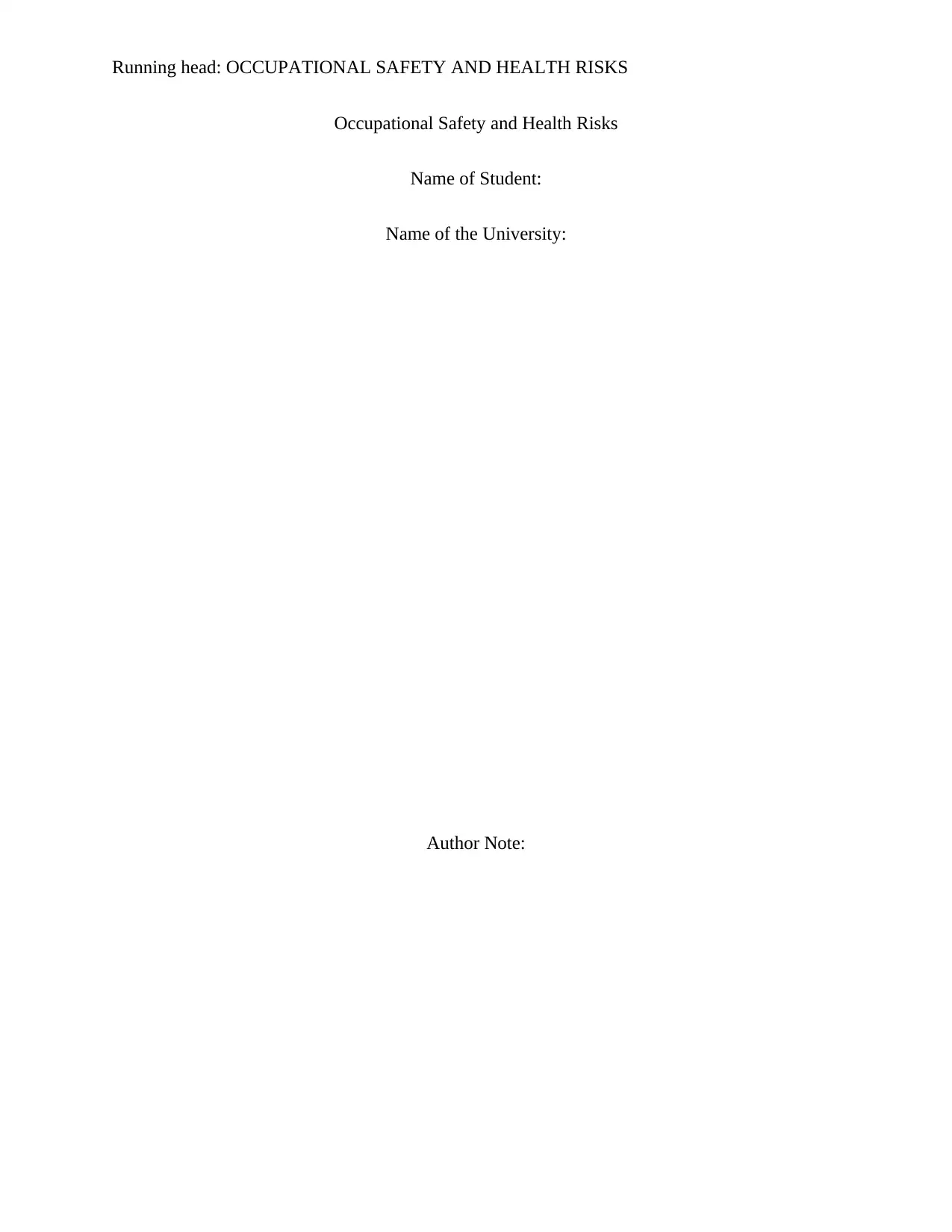
Running head: OCCUPATIONAL SAFETY AND HEALTH RISKS
Occupational Safety and Health Risks
Name of Student:
Name of the University:
Author Note:
Occupational Safety and Health Risks
Name of Student:
Name of the University:
Author Note:
Paraphrase This Document
Need a fresh take? Get an instant paraphrase of this document with our AI Paraphraser
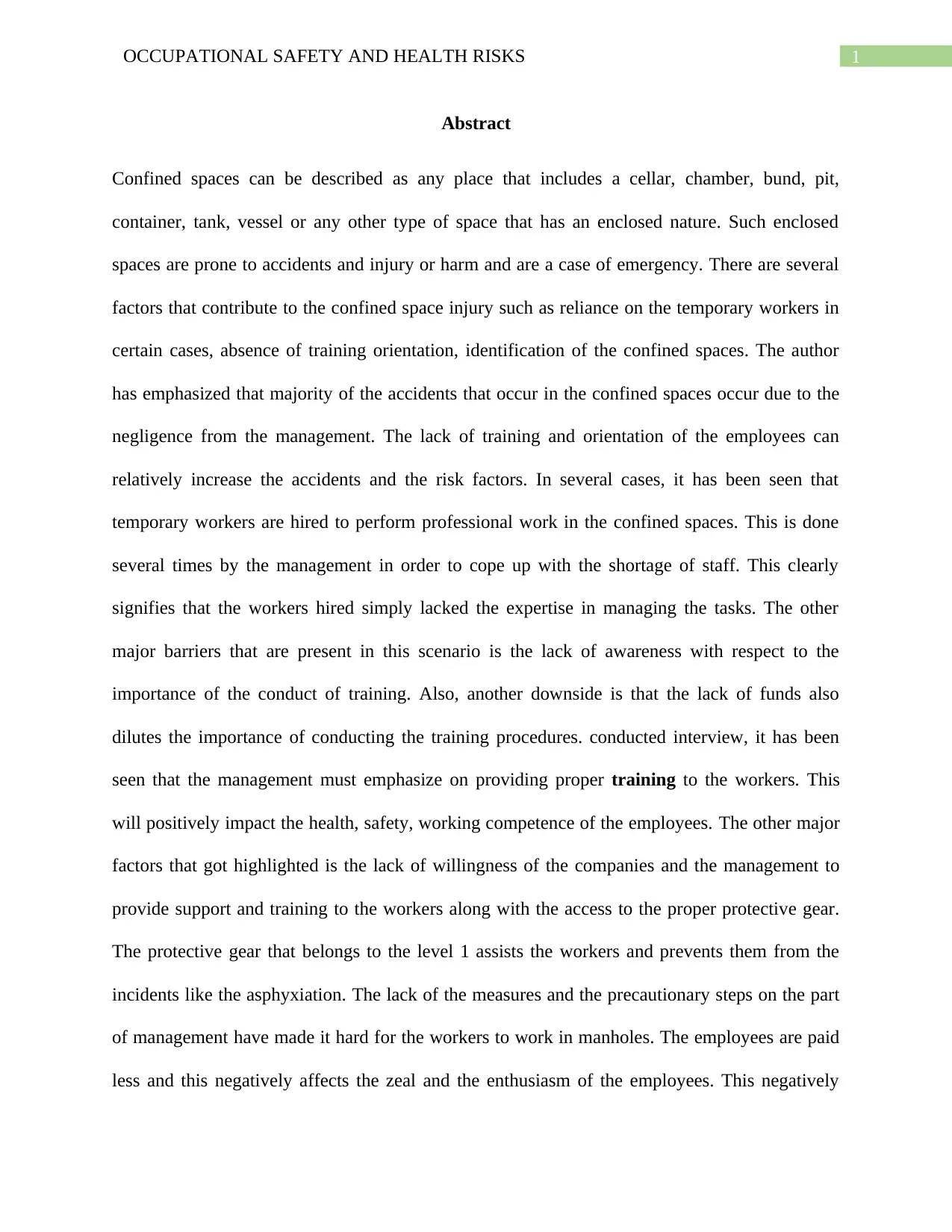
1OCCUPATIONAL SAFETY AND HEALTH RISKS
Abstract
Confined spaces can be described as any place that includes a cellar, chamber, bund, pit,
container, tank, vessel or any other type of space that has an enclosed nature. Such enclosed
spaces are prone to accidents and injury or harm and are a case of emergency. There are several
factors that contribute to the confined space injury such as reliance on the temporary workers in
certain cases, absence of training orientation, identification of the confined spaces. The author
has emphasized that majority of the accidents that occur in the confined spaces occur due to the
negligence from the management. The lack of training and orientation of the employees can
relatively increase the accidents and the risk factors. In several cases, it has been seen that
temporary workers are hired to perform professional work in the confined spaces. This is done
several times by the management in order to cope up with the shortage of staff. This clearly
signifies that the workers hired simply lacked the expertise in managing the tasks. The other
major barriers that are present in this scenario is the lack of awareness with respect to the
importance of the conduct of training. Also, another downside is that the lack of funds also
dilutes the importance of conducting the training procedures. conducted interview, it has been
seen that the management must emphasize on providing proper training to the workers. This
will positively impact the health, safety, working competence of the employees. The other major
factors that got highlighted is the lack of willingness of the companies and the management to
provide support and training to the workers along with the access to the proper protective gear.
The protective gear that belongs to the level 1 assists the workers and prevents them from the
incidents like the asphyxiation. The lack of the measures and the precautionary steps on the part
of management have made it hard for the workers to work in manholes. The employees are paid
less and this negatively affects the zeal and the enthusiasm of the employees. This negatively
Abstract
Confined spaces can be described as any place that includes a cellar, chamber, bund, pit,
container, tank, vessel or any other type of space that has an enclosed nature. Such enclosed
spaces are prone to accidents and injury or harm and are a case of emergency. There are several
factors that contribute to the confined space injury such as reliance on the temporary workers in
certain cases, absence of training orientation, identification of the confined spaces. The author
has emphasized that majority of the accidents that occur in the confined spaces occur due to the
negligence from the management. The lack of training and orientation of the employees can
relatively increase the accidents and the risk factors. In several cases, it has been seen that
temporary workers are hired to perform professional work in the confined spaces. This is done
several times by the management in order to cope up with the shortage of staff. This clearly
signifies that the workers hired simply lacked the expertise in managing the tasks. The other
major barriers that are present in this scenario is the lack of awareness with respect to the
importance of the conduct of training. Also, another downside is that the lack of funds also
dilutes the importance of conducting the training procedures. conducted interview, it has been
seen that the management must emphasize on providing proper training to the workers. This
will positively impact the health, safety, working competence of the employees. The other major
factors that got highlighted is the lack of willingness of the companies and the management to
provide support and training to the workers along with the access to the proper protective gear.
The protective gear that belongs to the level 1 assists the workers and prevents them from the
incidents like the asphyxiation. The lack of the measures and the precautionary steps on the part
of management have made it hard for the workers to work in manholes. The employees are paid
less and this negatively affects the zeal and the enthusiasm of the employees. This negatively
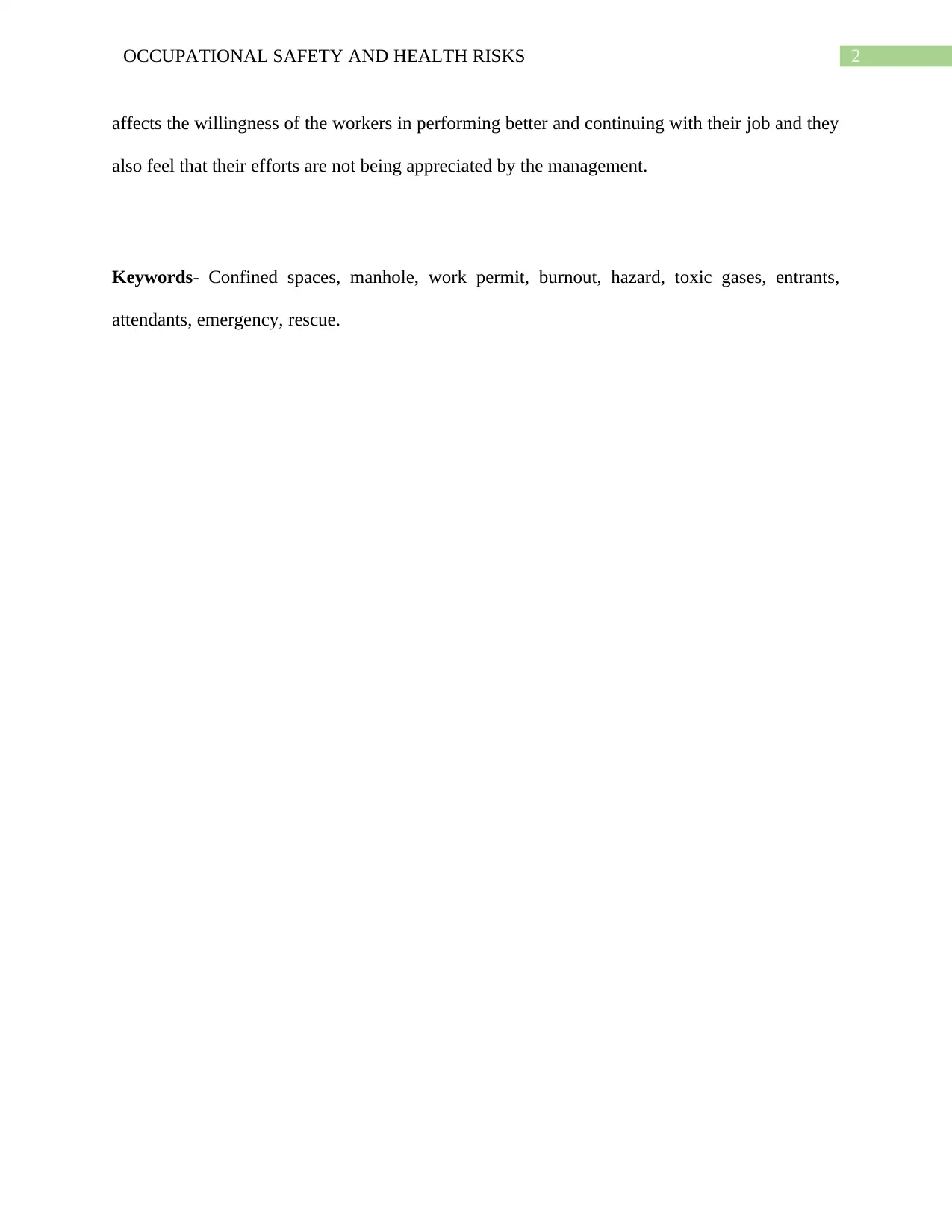
2OCCUPATIONAL SAFETY AND HEALTH RISKS
affects the willingness of the workers in performing better and continuing with their job and they
also feel that their efforts are not being appreciated by the management.
Keywords- Confined spaces, manhole, work permit, burnout, hazard, toxic gases, entrants,
attendants, emergency, rescue.
affects the willingness of the workers in performing better and continuing with their job and they
also feel that their efforts are not being appreciated by the management.
Keywords- Confined spaces, manhole, work permit, burnout, hazard, toxic gases, entrants,
attendants, emergency, rescue.
⊘ This is a preview!⊘
Do you want full access?
Subscribe today to unlock all pages.

Trusted by 1+ million students worldwide
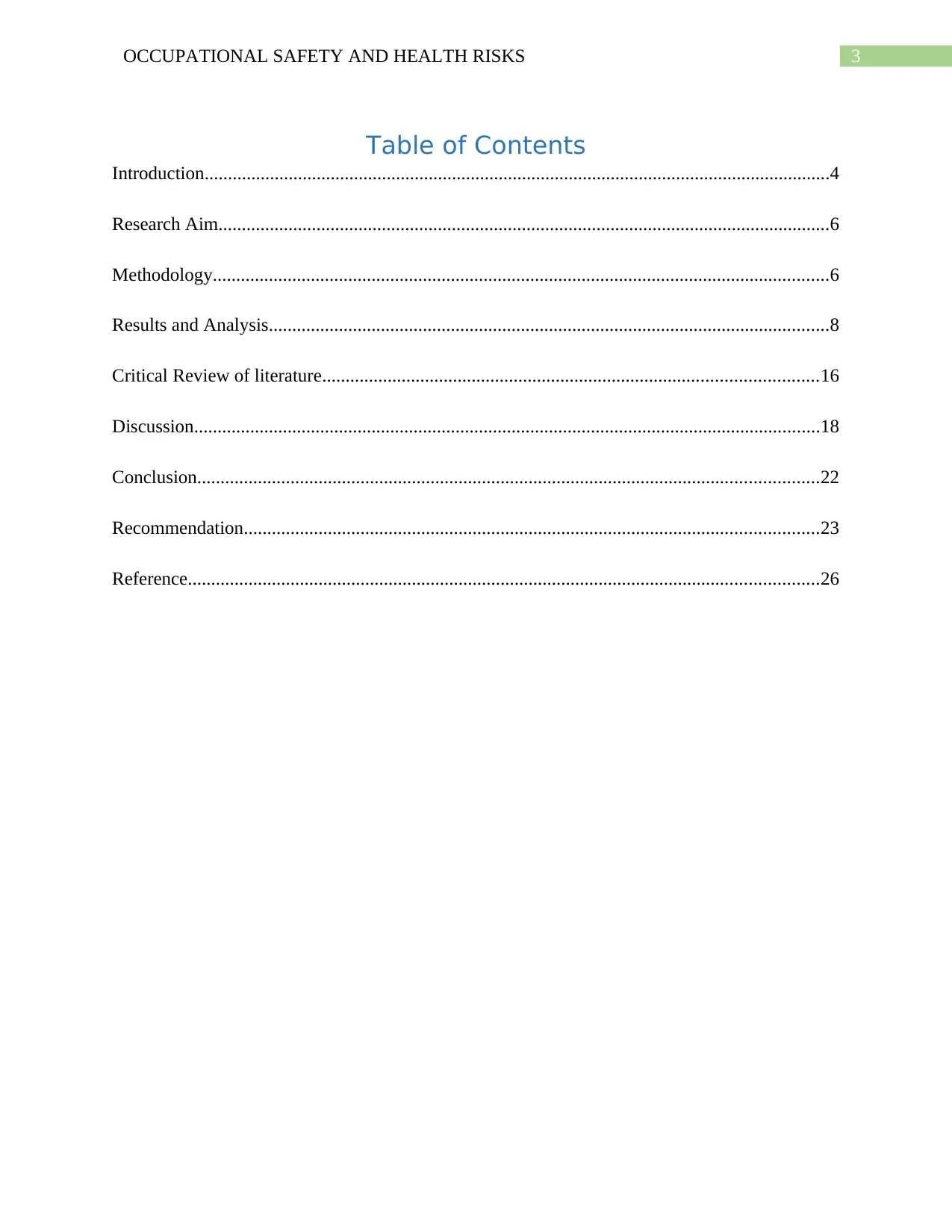
3OCCUPATIONAL SAFETY AND HEALTH RISKS
Table of Contents
Introduction......................................................................................................................................4
Research Aim...................................................................................................................................6
Methodology....................................................................................................................................6
Results and Analysis........................................................................................................................8
Critical Review of literature..........................................................................................................16
Discussion......................................................................................................................................18
Conclusion.....................................................................................................................................22
Recommendation...........................................................................................................................23
Reference.......................................................................................................................................26
Table of Contents
Introduction......................................................................................................................................4
Research Aim...................................................................................................................................6
Methodology....................................................................................................................................6
Results and Analysis........................................................................................................................8
Critical Review of literature..........................................................................................................16
Discussion......................................................................................................................................18
Conclusion.....................................................................................................................................22
Recommendation...........................................................................................................................23
Reference.......................................................................................................................................26
Paraphrase This Document
Need a fresh take? Get an instant paraphrase of this document with our AI Paraphraser
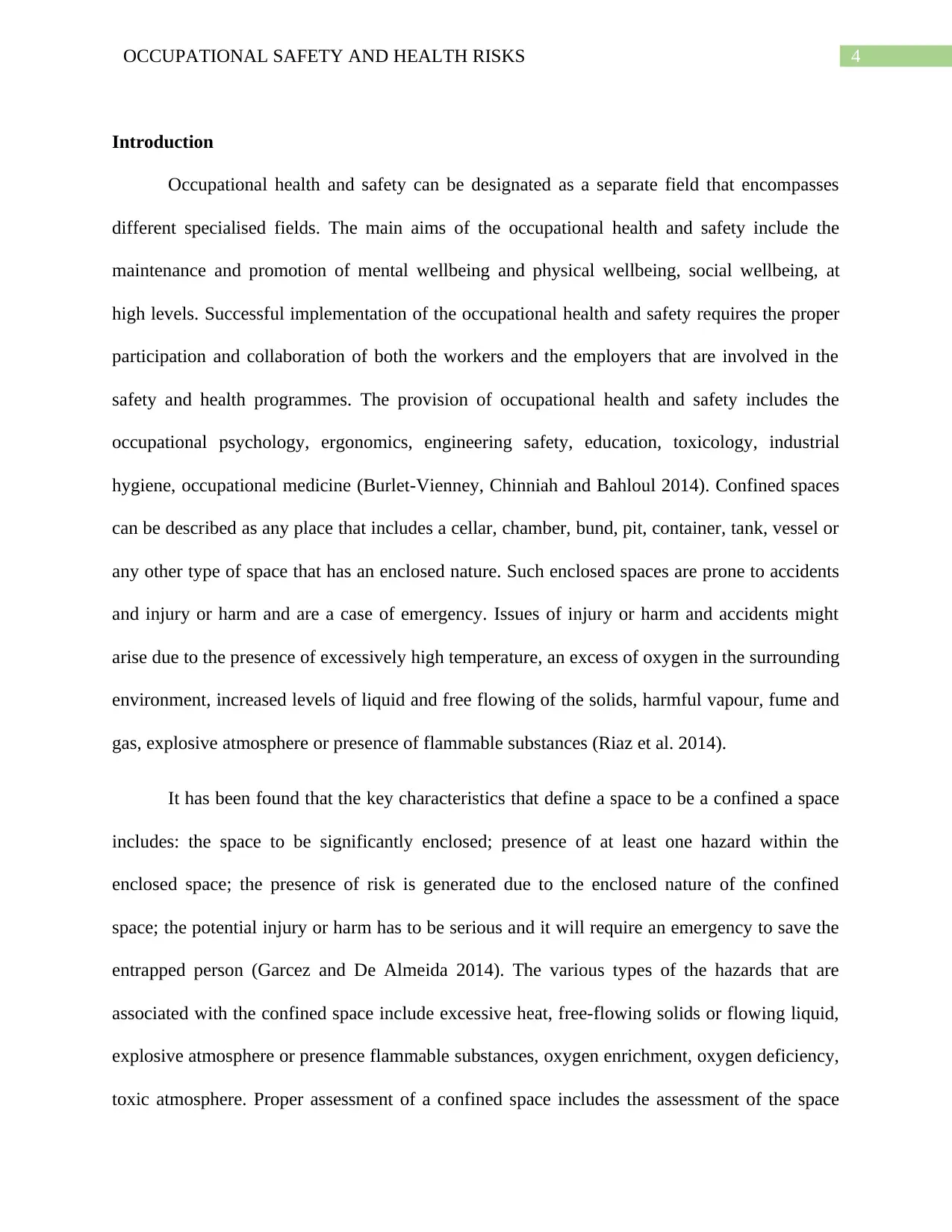
4OCCUPATIONAL SAFETY AND HEALTH RISKS
Introduction
Occupational health and safety can be designated as a separate field that encompasses
different specialised fields. The main aims of the occupational health and safety include the
maintenance and promotion of mental wellbeing and physical wellbeing, social wellbeing, at
high levels. Successful implementation of the occupational health and safety requires the proper
participation and collaboration of both the workers and the employers that are involved in the
safety and health programmes. The provision of occupational health and safety includes the
occupational psychology, ergonomics, engineering safety, education, toxicology, industrial
hygiene, occupational medicine (Burlet-Vienney, Chinniah and Bahloul 2014). Confined spaces
can be described as any place that includes a cellar, chamber, bund, pit, container, tank, vessel or
any other type of space that has an enclosed nature. Such enclosed spaces are prone to accidents
and injury or harm and are a case of emergency. Issues of injury or harm and accidents might
arise due to the presence of excessively high temperature, an excess of oxygen in the surrounding
environment, increased levels of liquid and free flowing of the solids, harmful vapour, fume and
gas, explosive atmosphere or presence of flammable substances (Riaz et al. 2014).
It has been found that the key characteristics that define a space to be a confined a space
includes: the space to be significantly enclosed; presence of at least one hazard within the
enclosed space; the presence of risk is generated due to the enclosed nature of the confined
space; the potential injury or harm has to be serious and it will require an emergency to save the
entrapped person (Garcez and De Almeida 2014). The various types of the hazards that are
associated with the confined space include excessive heat, free-flowing solids or flowing liquid,
explosive atmosphere or presence flammable substances, oxygen enrichment, oxygen deficiency,
toxic atmosphere. Proper assessment of a confined space includes the assessment of the space
Introduction
Occupational health and safety can be designated as a separate field that encompasses
different specialised fields. The main aims of the occupational health and safety include the
maintenance and promotion of mental wellbeing and physical wellbeing, social wellbeing, at
high levels. Successful implementation of the occupational health and safety requires the proper
participation and collaboration of both the workers and the employers that are involved in the
safety and health programmes. The provision of occupational health and safety includes the
occupational psychology, ergonomics, engineering safety, education, toxicology, industrial
hygiene, occupational medicine (Burlet-Vienney, Chinniah and Bahloul 2014). Confined spaces
can be described as any place that includes a cellar, chamber, bund, pit, container, tank, vessel or
any other type of space that has an enclosed nature. Such enclosed spaces are prone to accidents
and injury or harm and are a case of emergency. Issues of injury or harm and accidents might
arise due to the presence of excessively high temperature, an excess of oxygen in the surrounding
environment, increased levels of liquid and free flowing of the solids, harmful vapour, fume and
gas, explosive atmosphere or presence of flammable substances (Riaz et al. 2014).
It has been found that the key characteristics that define a space to be a confined a space
includes: the space to be significantly enclosed; presence of at least one hazard within the
enclosed space; the presence of risk is generated due to the enclosed nature of the confined
space; the potential injury or harm has to be serious and it will require an emergency to save the
entrapped person (Garcez and De Almeida 2014). The various types of the hazards that are
associated with the confined space include excessive heat, free-flowing solids or flowing liquid,
explosive atmosphere or presence flammable substances, oxygen enrichment, oxygen deficiency,
toxic atmosphere. Proper assessment of a confined space includes the assessment of the space
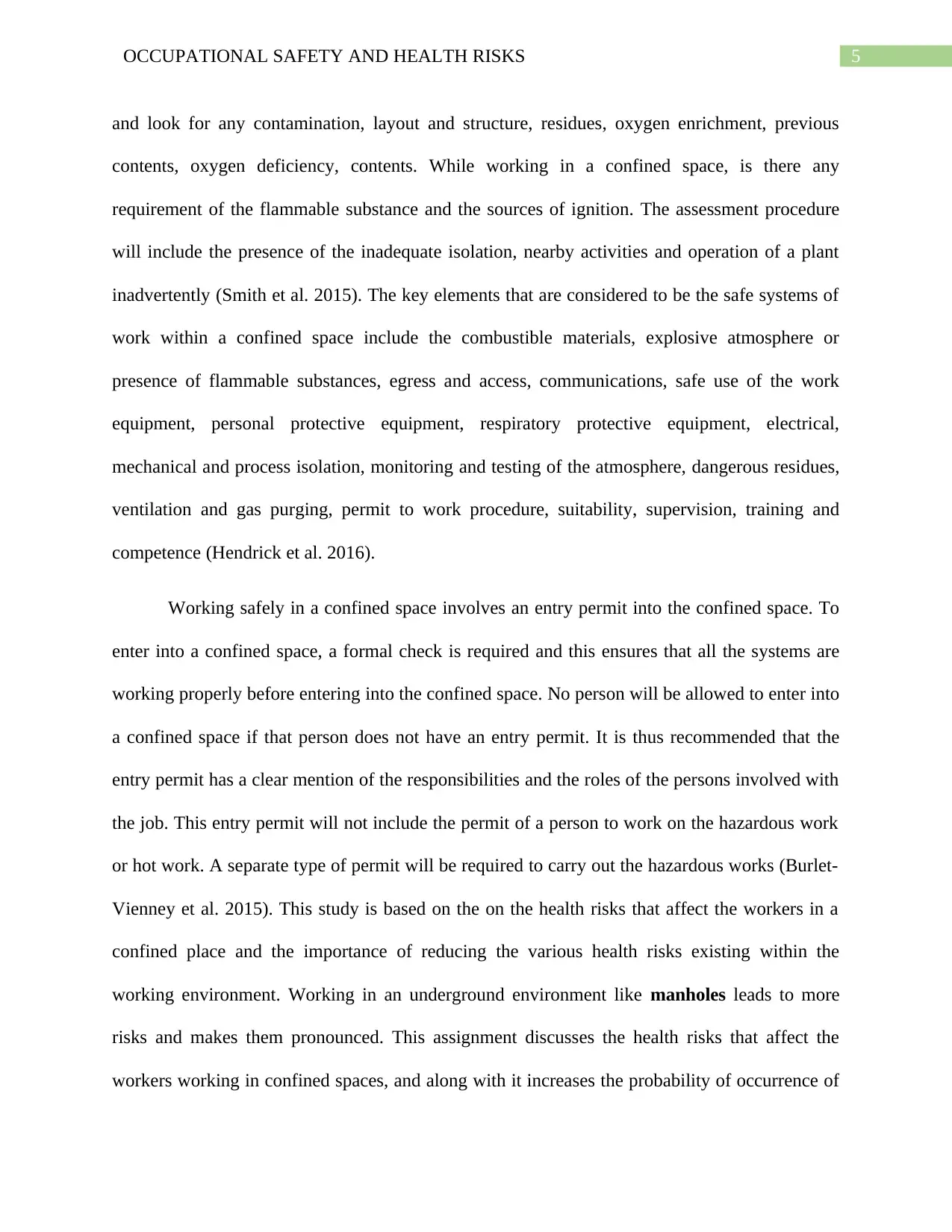
5OCCUPATIONAL SAFETY AND HEALTH RISKS
and look for any contamination, layout and structure, residues, oxygen enrichment, previous
contents, oxygen deficiency, contents. While working in a confined space, is there any
requirement of the flammable substance and the sources of ignition. The assessment procedure
will include the presence of the inadequate isolation, nearby activities and operation of a plant
inadvertently (Smith et al. 2015). The key elements that are considered to be the safe systems of
work within a confined space include the combustible materials, explosive atmosphere or
presence of flammable substances, egress and access, communications, safe use of the work
equipment, personal protective equipment, respiratory protective equipment, electrical,
mechanical and process isolation, monitoring and testing of the atmosphere, dangerous residues,
ventilation and gas purging, permit to work procedure, suitability, supervision, training and
competence (Hendrick et al. 2016).
Working safely in a confined space involves an entry permit into the confined space. To
enter into a confined space, a formal check is required and this ensures that all the systems are
working properly before entering into the confined space. No person will be allowed to enter into
a confined space if that person does not have an entry permit. It is thus recommended that the
entry permit has a clear mention of the responsibilities and the roles of the persons involved with
the job. This entry permit will not include the permit of a person to work on the hazardous work
or hot work. A separate type of permit will be required to carry out the hazardous works (Burlet-
Vienney et al. 2015). This study is based on the on the health risks that affect the workers in a
confined place and the importance of reducing the various health risks existing within the
working environment. Working in an underground environment like manholes leads to more
risks and makes them pronounced. This assignment discusses the health risks that affect the
workers working in confined spaces, and along with it increases the probability of occurrence of
and look for any contamination, layout and structure, residues, oxygen enrichment, previous
contents, oxygen deficiency, contents. While working in a confined space, is there any
requirement of the flammable substance and the sources of ignition. The assessment procedure
will include the presence of the inadequate isolation, nearby activities and operation of a plant
inadvertently (Smith et al. 2015). The key elements that are considered to be the safe systems of
work within a confined space include the combustible materials, explosive atmosphere or
presence of flammable substances, egress and access, communications, safe use of the work
equipment, personal protective equipment, respiratory protective equipment, electrical,
mechanical and process isolation, monitoring and testing of the atmosphere, dangerous residues,
ventilation and gas purging, permit to work procedure, suitability, supervision, training and
competence (Hendrick et al. 2016).
Working safely in a confined space involves an entry permit into the confined space. To
enter into a confined space, a formal check is required and this ensures that all the systems are
working properly before entering into the confined space. No person will be allowed to enter into
a confined space if that person does not have an entry permit. It is thus recommended that the
entry permit has a clear mention of the responsibilities and the roles of the persons involved with
the job. This entry permit will not include the permit of a person to work on the hazardous work
or hot work. A separate type of permit will be required to carry out the hazardous works (Burlet-
Vienney et al. 2015). This study is based on the on the health risks that affect the workers in a
confined place and the importance of reducing the various health risks existing within the
working environment. Working in an underground environment like manholes leads to more
risks and makes them pronounced. This assignment discusses the health risks that affect the
workers working in confined spaces, and along with it increases the probability of occurrence of
⊘ This is a preview!⊘
Do you want full access?
Subscribe today to unlock all pages.

Trusted by 1+ million students worldwide
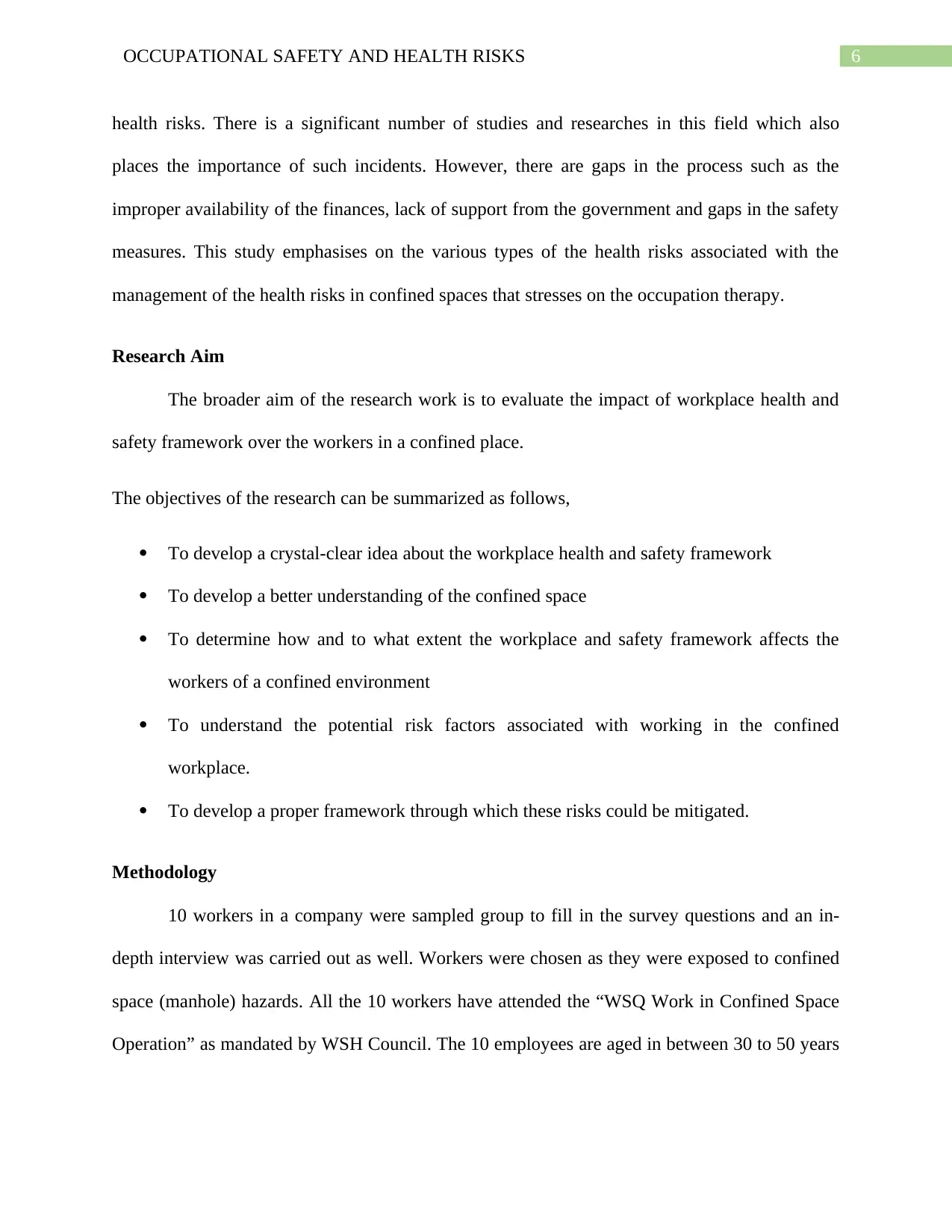
6OCCUPATIONAL SAFETY AND HEALTH RISKS
health risks. There is a significant number of studies and researches in this field which also
places the importance of such incidents. However, there are gaps in the process such as the
improper availability of the finances, lack of support from the government and gaps in the safety
measures. This study emphasises on the various types of the health risks associated with the
management of the health risks in confined spaces that stresses on the occupation therapy.
Research Aim
The broader aim of the research work is to evaluate the impact of workplace health and
safety framework over the workers in a confined place.
The objectives of the research can be summarized as follows,
To develop a crystal-clear idea about the workplace health and safety framework
To develop a better understanding of the confined space
To determine how and to what extent the workplace and safety framework affects the
workers of a confined environment
To understand the potential risk factors associated with working in the confined
workplace.
To develop a proper framework through which these risks could be mitigated.
Methodology
10 workers in a company were sampled group to fill in the survey questions and an in-
depth interview was carried out as well. Workers were chosen as they were exposed to confined
space (manhole) hazards. All the 10 workers have attended the “WSQ Work in Confined Space
Operation” as mandated by WSH Council. The 10 employees are aged in between 30 to 50 years
health risks. There is a significant number of studies and researches in this field which also
places the importance of such incidents. However, there are gaps in the process such as the
improper availability of the finances, lack of support from the government and gaps in the safety
measures. This study emphasises on the various types of the health risks associated with the
management of the health risks in confined spaces that stresses on the occupation therapy.
Research Aim
The broader aim of the research work is to evaluate the impact of workplace health and
safety framework over the workers in a confined place.
The objectives of the research can be summarized as follows,
To develop a crystal-clear idea about the workplace health and safety framework
To develop a better understanding of the confined space
To determine how and to what extent the workplace and safety framework affects the
workers of a confined environment
To understand the potential risk factors associated with working in the confined
workplace.
To develop a proper framework through which these risks could be mitigated.
Methodology
10 workers in a company were sampled group to fill in the survey questions and an in-
depth interview was carried out as well. Workers were chosen as they were exposed to confined
space (manhole) hazards. All the 10 workers have attended the “WSQ Work in Confined Space
Operation” as mandated by WSH Council. The 10 employees are aged in between 30 to 50 years
Paraphrase This Document
Need a fresh take? Get an instant paraphrase of this document with our AI Paraphraser
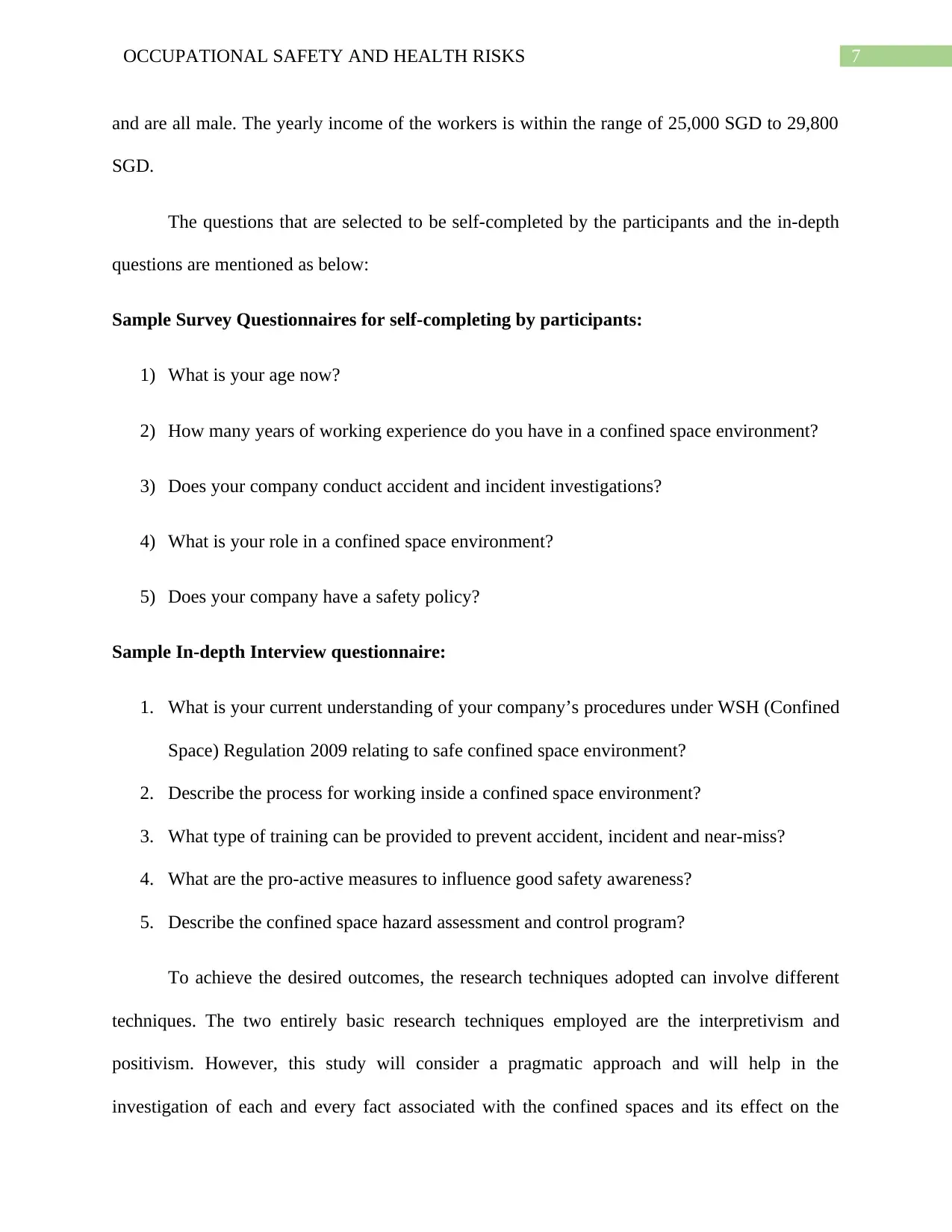
7OCCUPATIONAL SAFETY AND HEALTH RISKS
and are all male. The yearly income of the workers is within the range of 25,000 SGD to 29,800
SGD.
The questions that are selected to be self-completed by the participants and the in-depth
questions are mentioned as below:
Sample Survey Questionnaires for self-completing by participants:
1) What is your age now?
2) How many years of working experience do you have in a confined space environment?
3) Does your company conduct accident and incident investigations?
4) What is your role in a confined space environment?
5) Does your company have a safety policy?
Sample In-depth Interview questionnaire:
1. What is your current understanding of your company’s procedures under WSH (Confined
Space) Regulation 2009 relating to safe confined space environment?
2. Describe the process for working inside a confined space environment?
3. What type of training can be provided to prevent accident, incident and near-miss?
4. What are the pro-active measures to influence good safety awareness?
5. Describe the confined space hazard assessment and control program?
To achieve the desired outcomes, the research techniques adopted can involve different
techniques. The two entirely basic research techniques employed are the interpretivism and
positivism. However, this study will consider a pragmatic approach and will help in the
investigation of each and every fact associated with the confined spaces and its effect on the
and are all male. The yearly income of the workers is within the range of 25,000 SGD to 29,800
SGD.
The questions that are selected to be self-completed by the participants and the in-depth
questions are mentioned as below:
Sample Survey Questionnaires for self-completing by participants:
1) What is your age now?
2) How many years of working experience do you have in a confined space environment?
3) Does your company conduct accident and incident investigations?
4) What is your role in a confined space environment?
5) Does your company have a safety policy?
Sample In-depth Interview questionnaire:
1. What is your current understanding of your company’s procedures under WSH (Confined
Space) Regulation 2009 relating to safe confined space environment?
2. Describe the process for working inside a confined space environment?
3. What type of training can be provided to prevent accident, incident and near-miss?
4. What are the pro-active measures to influence good safety awareness?
5. Describe the confined space hazard assessment and control program?
To achieve the desired outcomes, the research techniques adopted can involve different
techniques. The two entirely basic research techniques employed are the interpretivism and
positivism. However, this study will consider a pragmatic approach and will help in the
investigation of each and every fact associated with the confined spaces and its effect on the
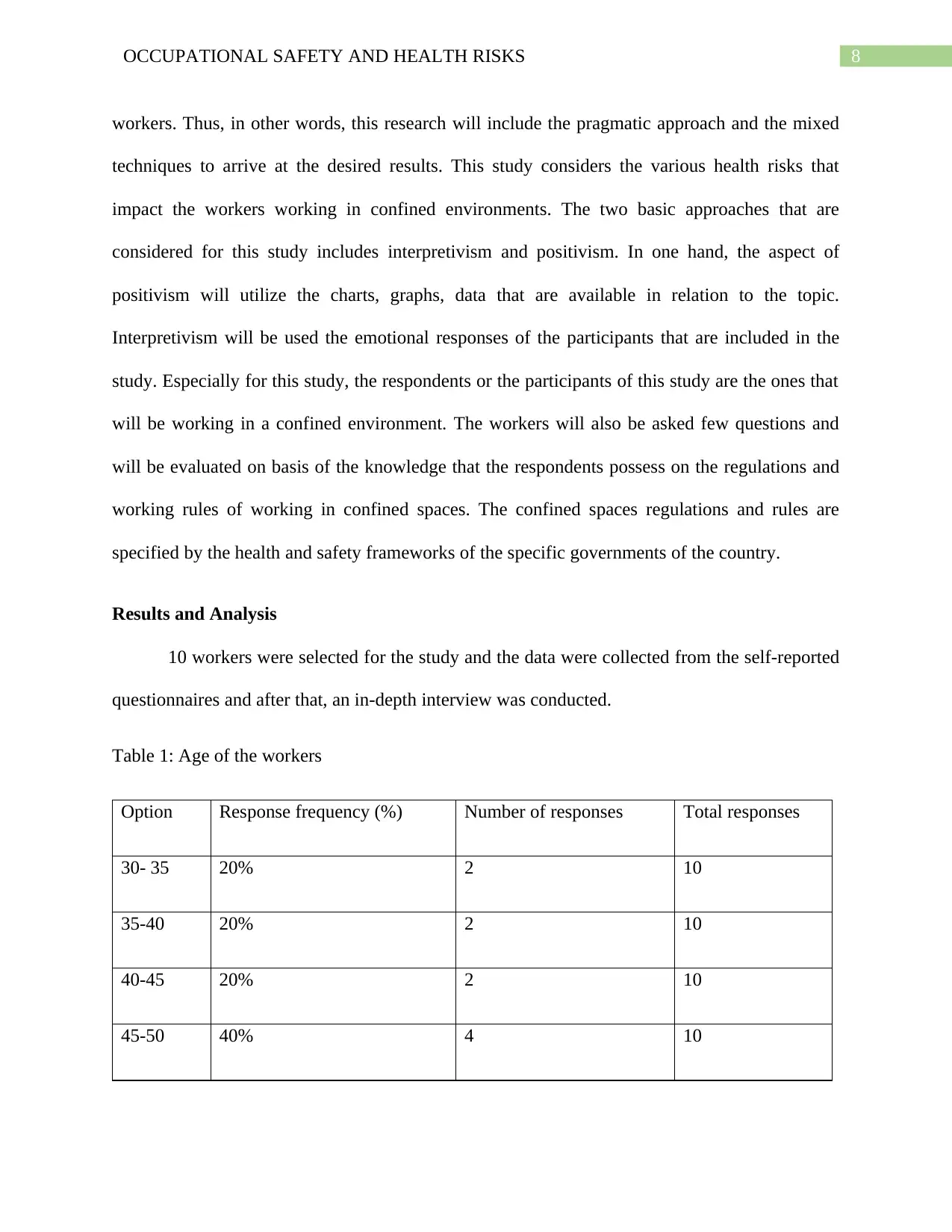
8OCCUPATIONAL SAFETY AND HEALTH RISKS
workers. Thus, in other words, this research will include the pragmatic approach and the mixed
techniques to arrive at the desired results. This study considers the various health risks that
impact the workers working in confined environments. The two basic approaches that are
considered for this study includes interpretivism and positivism. In one hand, the aspect of
positivism will utilize the charts, graphs, data that are available in relation to the topic.
Interpretivism will be used the emotional responses of the participants that are included in the
study. Especially for this study, the respondents or the participants of this study are the ones that
will be working in a confined environment. The workers will also be asked few questions and
will be evaluated on basis of the knowledge that the respondents possess on the regulations and
working rules of working in confined spaces. The confined spaces regulations and rules are
specified by the health and safety frameworks of the specific governments of the country.
Results and Analysis
10 workers were selected for the study and the data were collected from the self-reported
questionnaires and after that, an in-depth interview was conducted.
Table 1: Age of the workers
Option Response frequency (%) Number of responses Total responses
30- 35 20% 2 10
35-40 20% 2 10
40-45 20% 2 10
45-50 40% 4 10
workers. Thus, in other words, this research will include the pragmatic approach and the mixed
techniques to arrive at the desired results. This study considers the various health risks that
impact the workers working in confined environments. The two basic approaches that are
considered for this study includes interpretivism and positivism. In one hand, the aspect of
positivism will utilize the charts, graphs, data that are available in relation to the topic.
Interpretivism will be used the emotional responses of the participants that are included in the
study. Especially for this study, the respondents or the participants of this study are the ones that
will be working in a confined environment. The workers will also be asked few questions and
will be evaluated on basis of the knowledge that the respondents possess on the regulations and
working rules of working in confined spaces. The confined spaces regulations and rules are
specified by the health and safety frameworks of the specific governments of the country.
Results and Analysis
10 workers were selected for the study and the data were collected from the self-reported
questionnaires and after that, an in-depth interview was conducted.
Table 1: Age of the workers
Option Response frequency (%) Number of responses Total responses
30- 35 20% 2 10
35-40 20% 2 10
40-45 20% 2 10
45-50 40% 4 10
⊘ This is a preview!⊘
Do you want full access?
Subscribe today to unlock all pages.

Trusted by 1+ million students worldwide
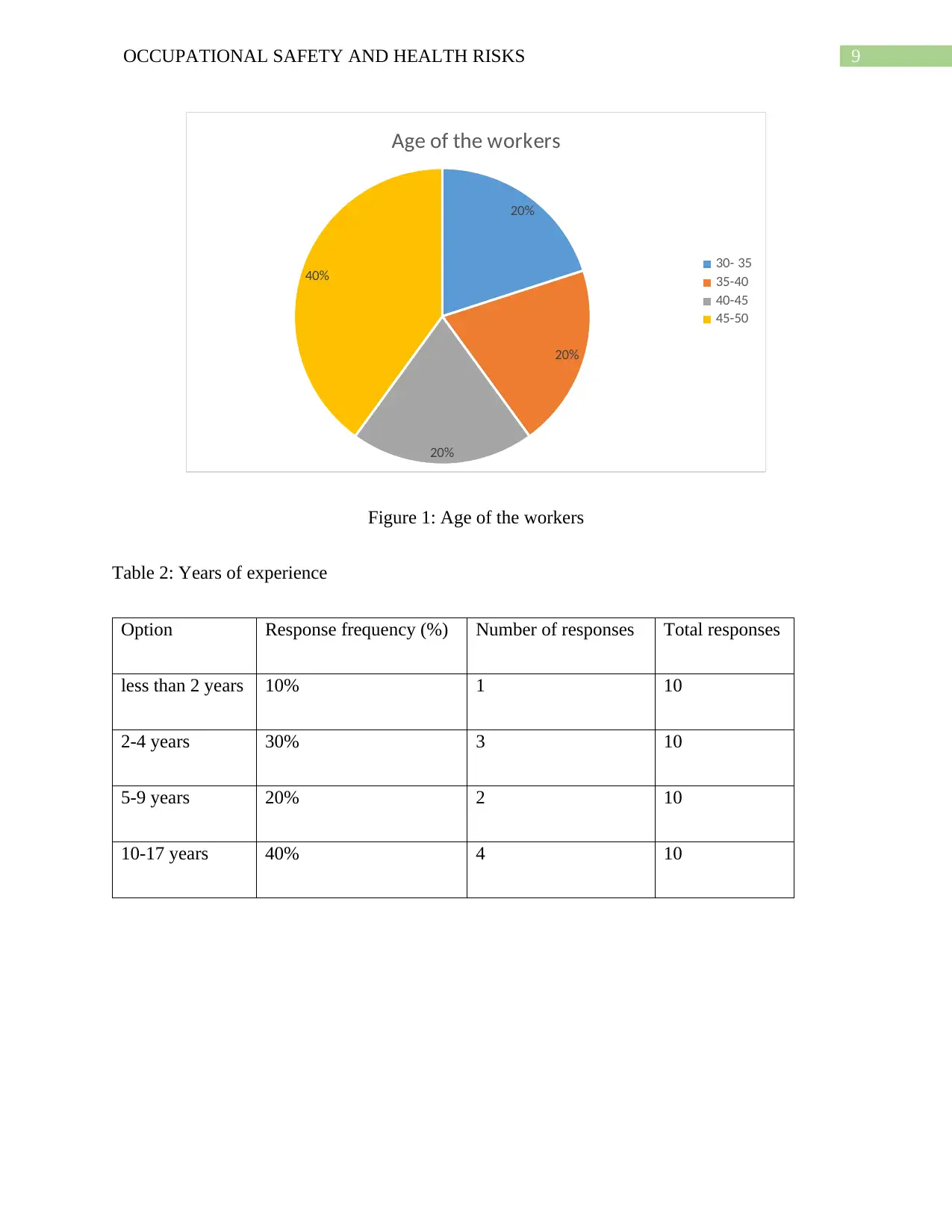
9OCCUPATIONAL SAFETY AND HEALTH RISKS
20%
20%
20%
40%
Age of the workers
30- 35
35-40
40-45
45-50
Figure 1: Age of the workers
Table 2: Years of experience
Option Response frequency (%) Number of responses Total responses
less than 2 years 10% 1 10
2-4 years 30% 3 10
5-9 years 20% 2 10
10-17 years 40% 4 10
20%
20%
20%
40%
Age of the workers
30- 35
35-40
40-45
45-50
Figure 1: Age of the workers
Table 2: Years of experience
Option Response frequency (%) Number of responses Total responses
less than 2 years 10% 1 10
2-4 years 30% 3 10
5-9 years 20% 2 10
10-17 years 40% 4 10
Paraphrase This Document
Need a fresh take? Get an instant paraphrase of this document with our AI Paraphraser
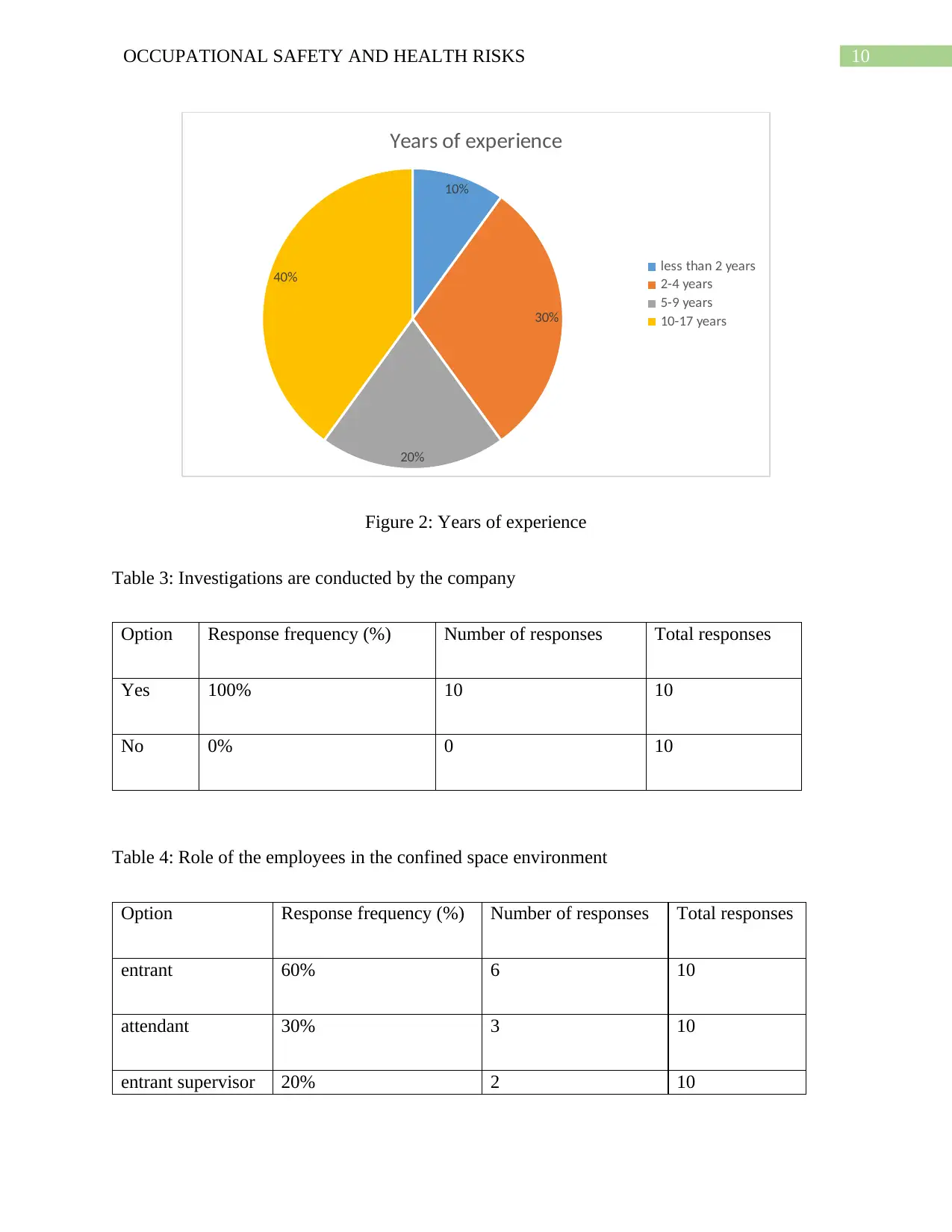
10OCCUPATIONAL SAFETY AND HEALTH RISKS
10%
30%
20%
40%
Years of experience
less than 2 years
2-4 years
5-9 years
10-17 years
Figure 2: Years of experience
Table 3: Investigations are conducted by the company
Option Response frequency (%) Number of responses Total responses
Yes 100% 10 10
No 0% 0 10
Table 4: Role of the employees in the confined space environment
Option Response frequency (%) Number of responses Total responses
entrant 60% 6 10
attendant 30% 3 10
entrant supervisor 20% 2 10
10%
30%
20%
40%
Years of experience
less than 2 years
2-4 years
5-9 years
10-17 years
Figure 2: Years of experience
Table 3: Investigations are conducted by the company
Option Response frequency (%) Number of responses Total responses
Yes 100% 10 10
No 0% 0 10
Table 4: Role of the employees in the confined space environment
Option Response frequency (%) Number of responses Total responses
entrant 60% 6 10
attendant 30% 3 10
entrant supervisor 20% 2 10
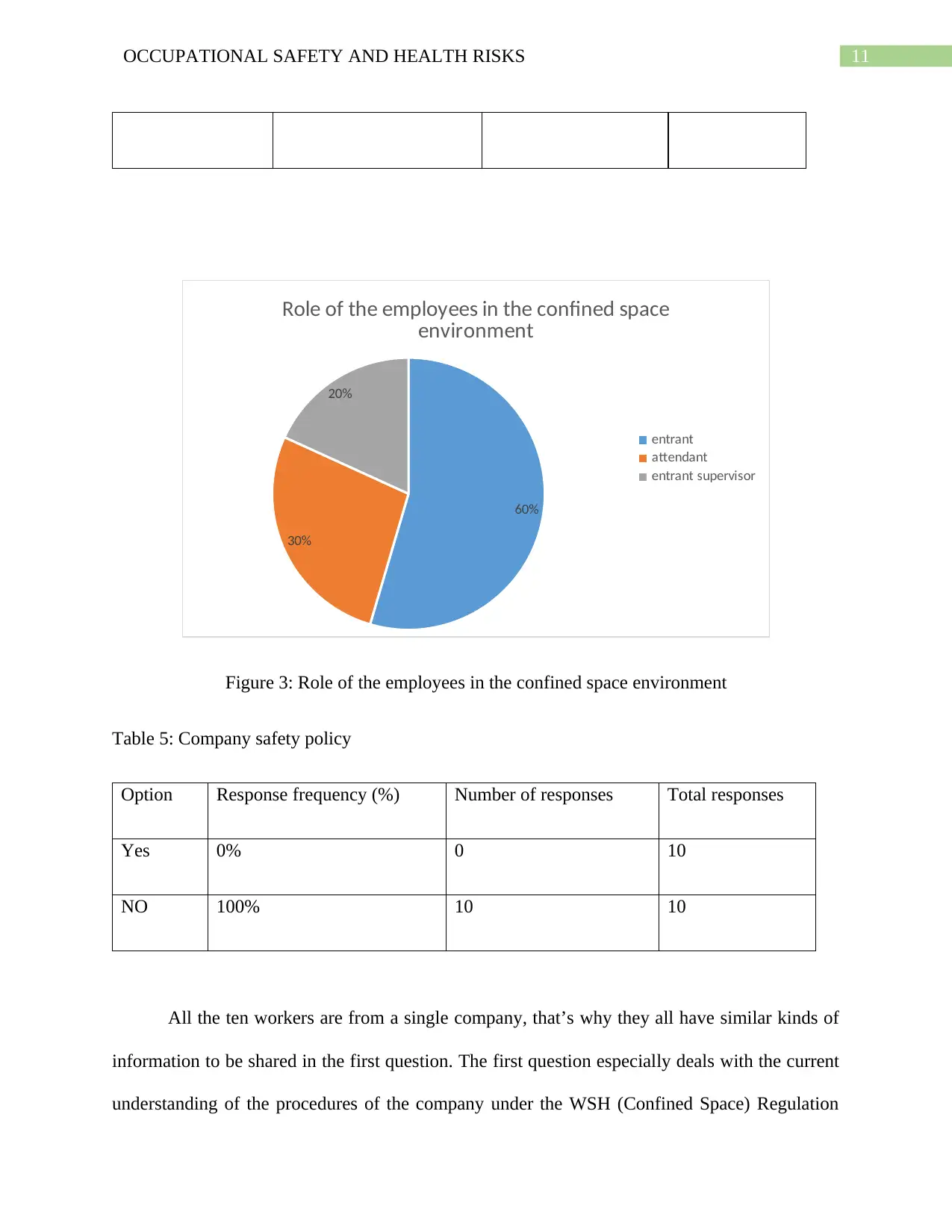
11OCCUPATIONAL SAFETY AND HEALTH RISKS
60%
30%
20%
Role of the employees in the confined space
environment
entrant
attendant
entrant supervisor
Figure 3: Role of the employees in the confined space environment
Table 5: Company safety policy
Option Response frequency (%) Number of responses Total responses
Yes 0% 0 10
NO 100% 10 10
All the ten workers are from a single company, that’s why they all have similar kinds of
information to be shared in the first question. The first question especially deals with the current
understanding of the procedures of the company under the WSH (Confined Space) Regulation
60%
30%
20%
Role of the employees in the confined space
environment
entrant
attendant
entrant supervisor
Figure 3: Role of the employees in the confined space environment
Table 5: Company safety policy
Option Response frequency (%) Number of responses Total responses
Yes 0% 0 10
NO 100% 10 10
All the ten workers are from a single company, that’s why they all have similar kinds of
information to be shared in the first question. The first question especially deals with the current
understanding of the procedures of the company under the WSH (Confined Space) Regulation
⊘ This is a preview!⊘
Do you want full access?
Subscribe today to unlock all pages.

Trusted by 1+ million students worldwide
1 out of 31
Related Documents
Your All-in-One AI-Powered Toolkit for Academic Success.
+13062052269
info@desklib.com
Available 24*7 on WhatsApp / Email
![[object Object]](/_next/static/media/star-bottom.7253800d.svg)
Unlock your academic potential
Copyright © 2020–2025 A2Z Services. All Rights Reserved. Developed and managed by ZUCOL.





